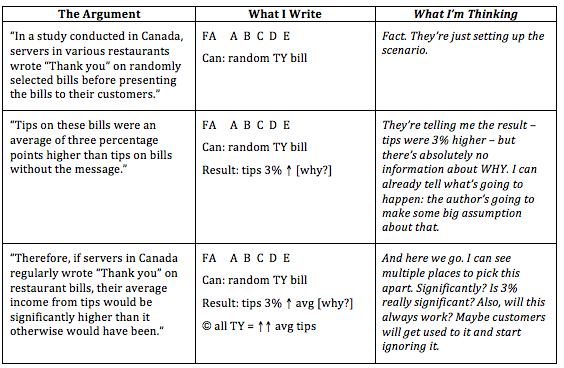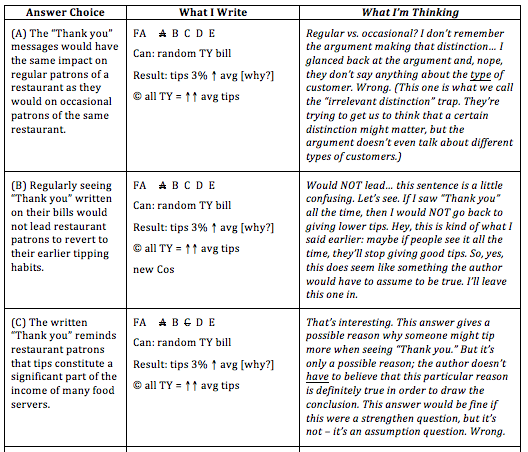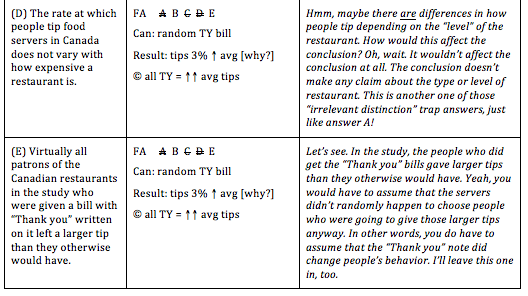-
Target Test Prep 20% Off Flash Sale is on! Code: FLASH20
Redeem
Tackling Find the Assumption CR Problems
 Find the Assumption questions are very common Critical Reasoning question types. If you dont yet know the general process for tackling Critical Reasoning problems, learn how before you keep reading this article.
Find the Assumption questions are very common Critical Reasoning question types. If you dont yet know the general process for tackling Critical Reasoning problems, learn how before you keep reading this article.
Ready to try a question? Set your timer for 2 minutes and try this GMATPrep problem:
In a study conducted in Canada, servers in various restaurants wrote Thank you on randomly selected bills before presenting the bills to their customers. Tips on these bills were an average of three percentage points higher than tips on bills without the message. Therefore, if servers in Canada regularly wrote Thank you on restaurant bills, their average income from tips would be significantly higher than it otherwise would have been.Which of the following is an assumption on which the argument relies?
(A) The Thank you messages would have the same impact on regular patrons of a restaurant as they would on occasional patrons of the same restaurant.(B) Regularly seeing Thank you written on their bills would not lead restaurant patrons to revert to their earlier tipping habits.
(C) The written Thank you reminds restaurant patrons that tips constitute a significant part of the income of many food servers.
(D) The rate at which people tip food servers in Canada does not vary with how expensive a restaurant is.
(E) Virtually all patrons of the Canadian restaurants in the study who were given a bill with Thank you written on it left a larger tip than they otherwise would have.
Got your answer? Lets start going through this one!
Step 1: Identify the Question
The question stem contains the word assumption, which is a pretty good clue that this is a Find the Assumption (FA) question. This question type always contains a conclusion and I know its important to find that conclusion. Also, if I can, Im going to brainstorm any assumptions I can think of without taking too much time.
Step 2: Deconstruct the Argument
Here, Ill show you what Im thinking while I read the argument and also how I would take notes. Your own thought process wont be exactly the same as mine and, of course, your notes will probably look quite different, since we all have our own ways of abbreviating things.

Ive thought of a couple of different lines of attack. First, maybe theres something around the word significant. Also, the author is assuming that what happened during the study will continue to happen in future, but maybe theres some reason why that wouldnt happen. I can imagine that I might respond by giving a larger tip the first couple of times I saw Thank you, thinking the server had taken extra care to write the note but if everybody did it, it wouldnt have the same impact.
Note: Im not really articulating all of the above to myself in so many words theres not enough time. But quick ideas or impressions come to us as we read these arguments, and the above would be my general impression for this one.
Step 3: State the Goal
This is an assumption question, so I have to find something the author MUST believe to be true in order to draw this conclusion (that writing Thank you on the bill will result in significantly greater tips on average).
Work from Wrong to Right


We still have two answers left, B and E, so now we compare them.
Wow, I was pretty convinced when I read answer B, but now that Ive read E, I think that one is it! Argh.
Okay, answer B addresses the issue of whether there would be an unintended consequence of seeing Thank you all the time if people who see it all the time then start ignoring it and go back to their old tipping habits, then the servers arent going to maintain that increase in their tips. Does the argument say that the result (significantly more in tips) would be short-term? No, it implies that this increase would be permanent. It wouldnt be, though, if people did revert to their old tipping habits, so the author really does have to assume that people wont go back to their old habits. B is still looking good.
What about E? I still like the fact that this answer says that the Thank you people gave larger tips than they otherwise would have. But both answers cant be right! Is there anything else here? Oh, I think I see. At the beginning, the answer says that virtually all patrons gave higher tips. Is it necessary to assume that they all or almost all gave higher tips? Maybe a smaller portion gave much higher tips, and so the overall increase averaged to 3%. Let me just check the conclusion yes, Ive got it! The conclusion also just talks about an average increase, so the author is not assuming that everyone gives higher tips just that some people do.
The correct answer is B.
Also, Im pretty impressed by that wrong answer E. One part of it is an actual assumption the author does have to assume that the Thank you note did specifically cause the change in behavior. The problem with E was that it went too far in assuming that virtually all of the people changed their behavior. That was seriously tricky.
Take-aways for Find the Assumption (FA) CR questions:
(1) Know how to identify the question type. Most FA questions contain some form of the word assume or assumption, though occasionally the question will ask what information is required or what information would allow the conclusion to be more properly drawn.
(2) Deconstruct the argument according to the goals for this type. FA questions all have conclusions and they all hinge on finding some assumption, so I should be looking for these things as I read the argument. I dont have endless time to brainstorm assumptions; Ill have a better shot at thinking of one or two efficiently if I know to think about it while Im reading the argument for the first time.
(3) Remind yourself of your goal. At first, you may need to say to yourself: For FA questions, I need to find something that the author must believe to be true in order to draw that conclusion. Some trap answers might involve something the author could believe to be true, but thats not good enough. Longer term, you may be able to say to yourself, simply, "Find Assumption" and know what that entails.
(4) Cross off wrong answers first, then worry about finding the right answer. Dont waste time trying to decide whether B is actually correct when you havent looked at C, D, or E yet. Eliminate first, then compare any remaining answers, as we did on this problem. Watch out for traps! On Assumption questions, one common trap answer tells us something thats reasonable to believe could be true (such as answer C), but the author doesnt absolutely have to believe that its true in order to get to his conclusion. Another common trap is the irrelevant distinction trap, where the answer tries to make a distinction between two or more groups or categories, but those distinctions do not actually matter to the given conclusion, as in answers A and D.
* GMATPrep questions courtesy of the Graduate Management Admissions Council. Usage of this question does not imply endorsement by GMAC.
Recent Articles
Archive
- April 2024
- March 2024
- February 2024
- January 2024
- December 2023
- November 2023
- October 2023
- September 2023
- July 2023
- June 2023
- May 2023
- April 2023
- March 2023
- February 2023
- January 2023
- December 2022
- November 2022
- October 2022
- September 2022
- August 2022
- July 2022
- June 2022
- May 2022
- April 2022
- March 2022
- February 2022
- January 2022
- December 2021
- November 2021
- October 2021
- September 2021
- August 2021
- July 2021
- June 2021
- May 2021
- April 2021
- March 2021
- February 2021
- January 2021
- December 2020
- November 2020
- October 2020
- September 2020
- August 2020
- July 2020
- June 2020
- May 2020
- April 2020
- March 2020
- February 2020
- January 2020
- December 2019
- November 2019
- October 2019
- September 2019
- August 2019
- July 2019
- June 2019
- May 2019
- April 2019
- March 2019
- February 2019
- January 2019
- December 2018
- November 2018
- October 2018
- September 2018
- August 2018
- July 2018
- June 2018
- May 2018
- April 2018
- March 2018
- February 2018
- January 2018
- December 2017
- November 2017
- October 2017
- September 2017
- August 2017
- July 2017
- June 2017
- May 2017
- April 2017
- March 2017
- February 2017
- January 2017
- December 2016
- November 2016
- October 2016
- September 2016
- August 2016
- July 2016
- June 2016
- May 2016
- April 2016
- March 2016
- February 2016
- January 2016
- December 2015
- November 2015
- October 2015
- September 2015
- August 2015
- July 2015
- June 2015
- May 2015
- April 2015
- March 2015
- February 2015
- January 2015
- December 2014
- November 2014
- October 2014
- September 2014
- August 2014
- July 2014
- June 2014
- May 2014
- April 2014
- March 2014
- February 2014
- January 2014
- December 2013
- November 2013
- October 2013
- September 2013
- August 2013
- July 2013
- June 2013
- May 2013
- April 2013
- March 2013
- February 2013
- January 2013
- December 2012
- November 2012
- October 2012
- September 2012
- August 2012
- July 2012
- June 2012
- May 2012
- April 2012
- March 2012
- February 2012
- January 2012
- December 2011
- November 2011
- October 2011
- September 2011
- August 2011
- July 2011
- June 2011
- May 2011
- April 2011
- March 2011
- February 2011
- January 2011
- December 2010
- November 2010
- October 2010
- September 2010
- August 2010
- July 2010
- June 2010
- May 2010
- April 2010
- March 2010
- February 2010
- January 2010
- December 2009
- November 2009
- October 2009
- September 2009
- August 2009